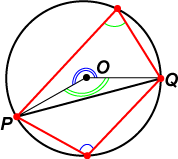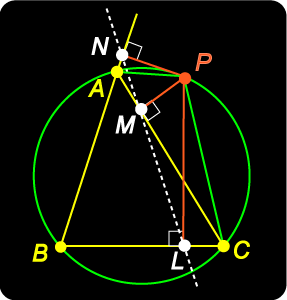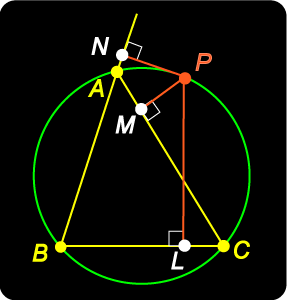5. THE SIMSON LINE
Points L, M, N on the sides BC, CA, AB (possibly extended) are chosen so that PL Can you make any conjecture about the points L, M, N ? Draw some other diagrams with different positions of the point P. Check ... Do some further exploration with this Java applet ... In what follows we shall need a property of cyclic quadrangles: |
The opposite angles of a cyclic quadrangle add to 180°.  This property follows easily from our previous result that the angle subtended by a chord PQ at the circumference is twice the angle subtended at the centre O of the circle. Since the green and blue angles at the centre add to 360°, the sum of the green and blue angles at the circumference add to 180°. This property follows easily from our previous result that the angle subtended by a chord PQ at the circumference is twice the angle subtended at the centre O of the circle. Since the green and blue angles at the centre add to 360°, the sum of the green and blue angles at the circumference add to 180°.It is also true that if the opposite angles of a quadrangle add to 180°, then the quadrangle is cyclic. |
The Simson Line
Proof: ( We must show that points L, M, N are collinear. To do this, we allow the possiblity that line LMN is ‘bent’ at M, and show that Now angles subtended by chord PN) = 180° – = opposite angles add to 180°) = = 180° – This establishes our result. Thus, L, M, N lie on a straight line. We now establish the result in the opposite direction ( |
Proof: ( To show that point P lies on the circumcircle of the triangle, we show that Now = 180° – opposite angles add to 180°) = add to 180°) = = 180° – This establishes our result. Thus, P lies on the circumcircle of |
1. Let PM meet the circumcircle again in the point M'. What may be true about the line BM' and the Simson line? Can you prove this? What other lines have this property? There are many more interesting results in this fascinating diagram! For looking up ... |
 Hints and Solutions Hints and Solutions
1. Let PM meet the circumcircle again in the point M'. What may be true about the line BM' and the Simson line? Can you prove this? |

 Exploring
Exploring